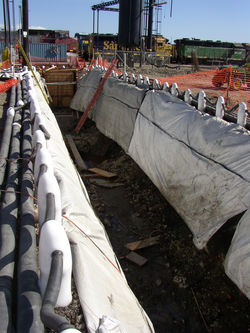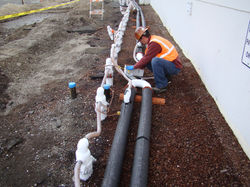Environmental Remediation
SoilFreeze considers every project a “green” project. Our “green” approach provides contractors and communities with shoring and ground water cut-off that is minimally invasive and completely restores the environment to its natural state after project completion. Electric equipment is used as well as an environmentally benign freeze medium. Noise pollution is minimal and can be reduced even further by the addition of easy-to-install sound barriers. Fragile ecosystems or nearby residents are not disturbed. We eliminate excessive vibrations, reuse 90% of our material, and recycle the rest.

We are always pleased to have the privilege of working on especially “green” projects. SoilFreeze has successfully completed projects that were designed to carefully protect such sensitive environments as a salmon creek in the Cascade foothills, the shore of Lake Tahoe, and the waters of the Yellowstone River in Montana.
Case Examples:
Our company roots started with the complete isolation of radioactive soil and contaminated groundwater from surrounding soils and aquifers. Addressing developing industry needs, we have expanded our technology for the isolation, removal, and replacement of soils contaminated with pesticides, herbicides, polychlorinated biphenyls, petroleum, and many other industrial pollutants. In all our soil remediation projects, we provide protection using our frozen soil system for existing infrastructure (pipes or building footings). Complete isolation can be achieved using the innovative “zone” freezing technology we have developed and used.
BNSF Pipeline Casing Trench
The Project
A new diesel fuel casing trench was constructed in a highly contaminated and active railroad yard.
Two parallel 20-inch diameter steel pipes and three access vaults needed to be installed. The depth of the excavation was approximately 12 feet.
The Challenge
Approximately 3 feet below the ground surface, highly contaminated groundwater was discovered. The water was polluted with petroleum product and although remediation of the contaminated soil and groundwater was not required at the site, a typical dewatering approach would result in the collection, storage, treatment, and discharge of a significant amount of water. In addition, there were rail lines that crossed the trench that needed to remain active for as long as possible.
The Solution
Frozen soil shoring was used to provide a stable shoring system for the excavation and cutoff contaminated groundwater inflow from outside the excavation. The system was installed adjacent to the rail lines and excavation was staged so disturbance to the rail system was limited during construction of the casing trench.
 |  |  |
|---|---|---|
 |  |  |
 |  |  |
 |  |
The Results
The excavation and construction of the casing trench was successful. Dewatering and associated collection, storage, treatment, and discharge of contaminated groundwater was significantly minimized and limited to the volume trapped within the limits of the excavation. No disturbance to the rail lines was measured during the freezing process.
BNSF D Street Remediation
The Project
A 12-foot to 15-foot deep remedial excavation was required at the site to remove and replace contaminated soil and groundwater from a historic railroad fueling facility. The excavation encompassed an area of approximately 0.6 acres and extended adjacent to an active roadway and operating businesses.
The Challenge
Located near the Thea Foss Waterway in an area that was historically mudflats and tidal marshes, the site has since been filled with thick layers of milled wood waste. The high groundwater at the site would typically require dewatering to achieve a stable excavation. However, this would result in a significant volume of contaminated water to treat. The contaminated groundwater adjacent to the site would begin to flow in as well.
The Solution
Frozen soil shoring was selected to provide a stable shoring system that contained the contaminated groundwater and cutoff groundwater inflow from outside the excavation. The system was installed through the wood waste, around utilities, and near adjacent structures/buildings with no vibration or disturbance to the surrounding properties.
 |  |  |
|---|---|---|
 |  |  |
 |  |  |
 |  |
The Project
The frozen soil shoring successfully froze the wood waste, providing a watertight shoring system and virtually eliminating dewatering and treatment requirements. The exposed frozen soil also allowed the contractor to evaluate the face of the excavation and characterize the contamination that remained in the soils underlying the adjacent buildings.


